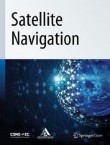Satellite Navigation is the official journal of the Aerospace Information Research Institute.
Assessing IGS GPS/Galileo/BDS-2/BDS-3 phase bias products with PRIDE PPP-AR
Ambiguity Resolution in Precise Point Positioning (PPP-AR) is important to achieving high-precision positioning in wide areas. The International GNSS (Global Navigation Satellite System) Service (IGS) and some...
